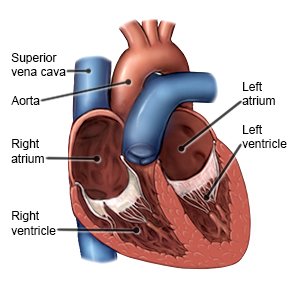Aortic Balloon Valvuloplasty
Medically reviewed by Drugs.com. Last updated on Sep 23, 2025.
Aortic balloon valvuloplasty is a procedure to open your aortic valve. This allows blood to flow more easily through your heart. The aortic valve is the door between the left ventricle and the aorta.
 |
WHILE YOU ARE HERE:
Before your procedure:
- Informed consent is a legal document that explains the tests, treatments, or procedures that you may need. Informed consent means you understand what will be done and can make decisions about what you want. You give your permission when you sign the consent form. You can have someone sign this form for you if you are not able to sign it. You have the right to understand your medical care in words you know. Before you sign the consent form, understand the risks and benefits of what will be done. Make sure all your questions are answered.
- An IV is a small tube placed in your vein that is used to give you medicine or liquids.
- A chest x-ray may be done to check your lungs and heart before or after the procedure. Healthcare providers may also use the x-ray to look for signs of infection.
- Contrast liquid may be injected into the catheter during your procedure. Contrast liquid helps make arteries, heart chambers, and the valve easier for healthcare providers to see. Tell your provider if you have ever had an allergic reaction to contrast liquid.
During your procedure:
- You will be given medicine in your IV to help you relax or make you drowsy. Local anesthesia will be used to numb your groin. You may still feel pressure or pushing during the procedure.
- A catheter with a balloon on the tip will be inserted into an artery in your groin and threaded into your heart. You may have a fluttering feeling in your chest. This is caused by extra heartbeats when the catheter is in your heart.
- When the end of the catheter is in the aortic valve, the balloon will be filled with liquid. This forces the valve to open so blood can flow more freely.
Related medications
After your procedure:
You will be taken to a room to rest until you are fully awake. Healthcare providers will monitor you closely for any problems. A bandage will cover the area where the catheter went in. The bandage puts pressure on your groin to prevent bleeding. A healthcare provider will check for bleeding or bruising.
- You must lie flat in bed for 6 to 8 hours after the procedure. Keep your leg straight and do not move around. Do not get out of bed until your healthcare provider says you can.
- Ice may be placed on your groin for 15 to 20 minutes every hour to relieve pain, swelling, or bruising.
- You may need to wear pressure stockings or inflatable boots after surgery. The stockings are tight and put pressure on your legs. The boots have an air pump that tightens and loosens different areas of the boots. Both of these improve blood flow and help prevent clots.
- Deep breathing and coughing will decrease your risk for a lung infection. Take a deep breath and hold it for as long as you can. Let the air out and then cough strongly. Deep breaths help open your airway. You may be given an incentive spirometer to help you take deep breaths. Put the plastic piece in your mouth and take a slow, deep breath, then let the air out and cough. Repeat these steps 10 times every hour.
- Medicines may be given to decrease pain or anxiety.
RISKS:
- You may bleed more than usual, develop an infection, or have trouble breathing. The artery in your groin may be damaged. The other valves or muscles in your heart could be damaged. You may have a stroke or heart attack if air bubbles or pieces of calcium from the valve go into your bloodstream. Your kidneys may stop working. You could have problems with your heartbeat. You may get a blood clot in your leg or arm. This may become life-threatening.
- Even after this procedure, your aortic valve may grow narrow again over time. If this happens, you may need to have the procedure again or have heart surgery.
CARE AGREEMENT:
You have the right to help plan your care. Learn about your health condition and how it may be treated. Discuss treatment options with your healthcare providers to decide what care you want to receive. You always have the right to refuse treatment.© Copyright Merative 2025 Information is for End User's use only and may not be sold, redistributed or otherwise used for commercial purposes.
The above information is an educational aid only. It is not intended as medical advice for individual conditions or treatments. Talk to your doctor, nurse or pharmacist before following any medical regimen to see if it is safe and effective for you.
Further information
Always consult your healthcare provider to ensure the information displayed on this page applies to your personal circumstances.
